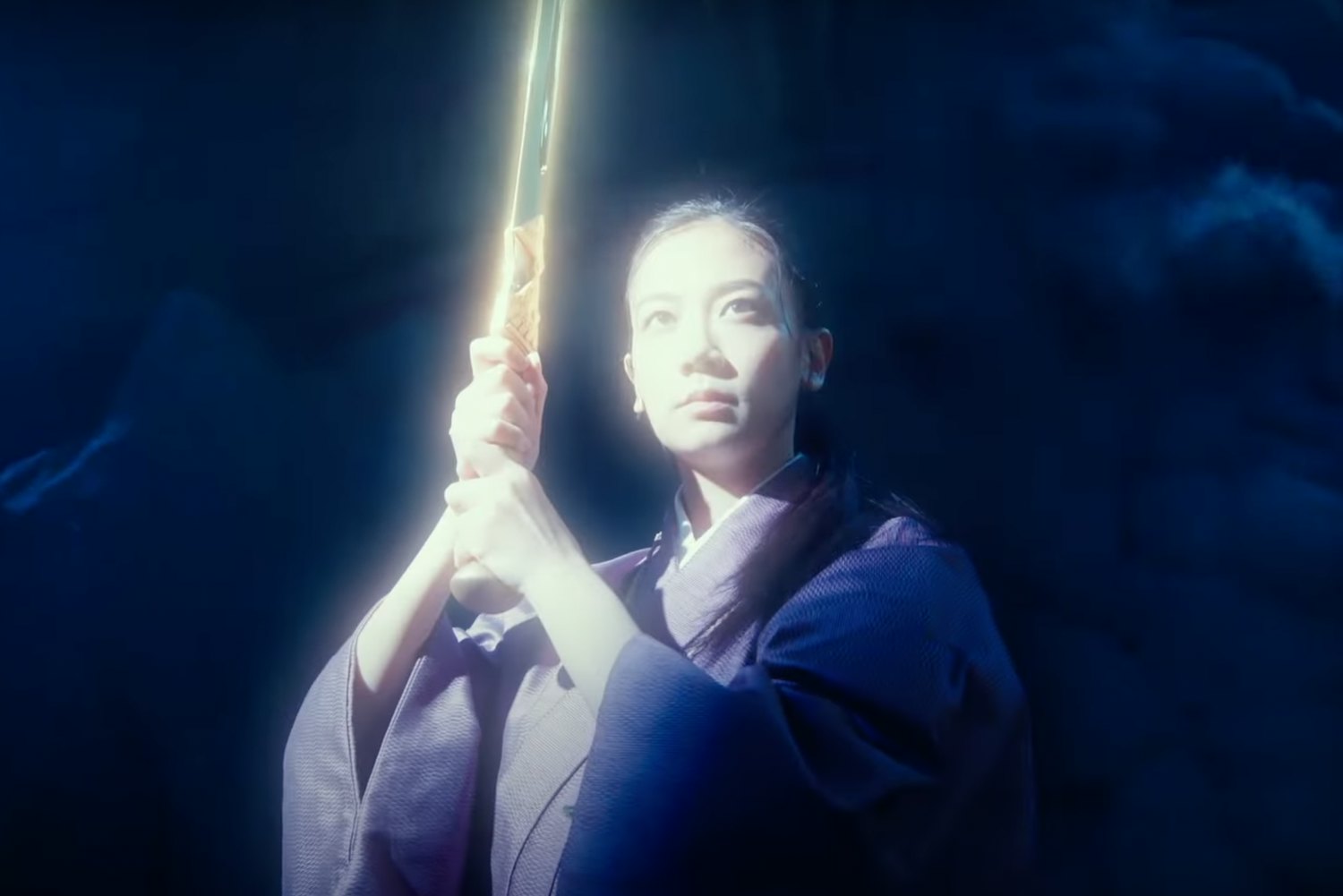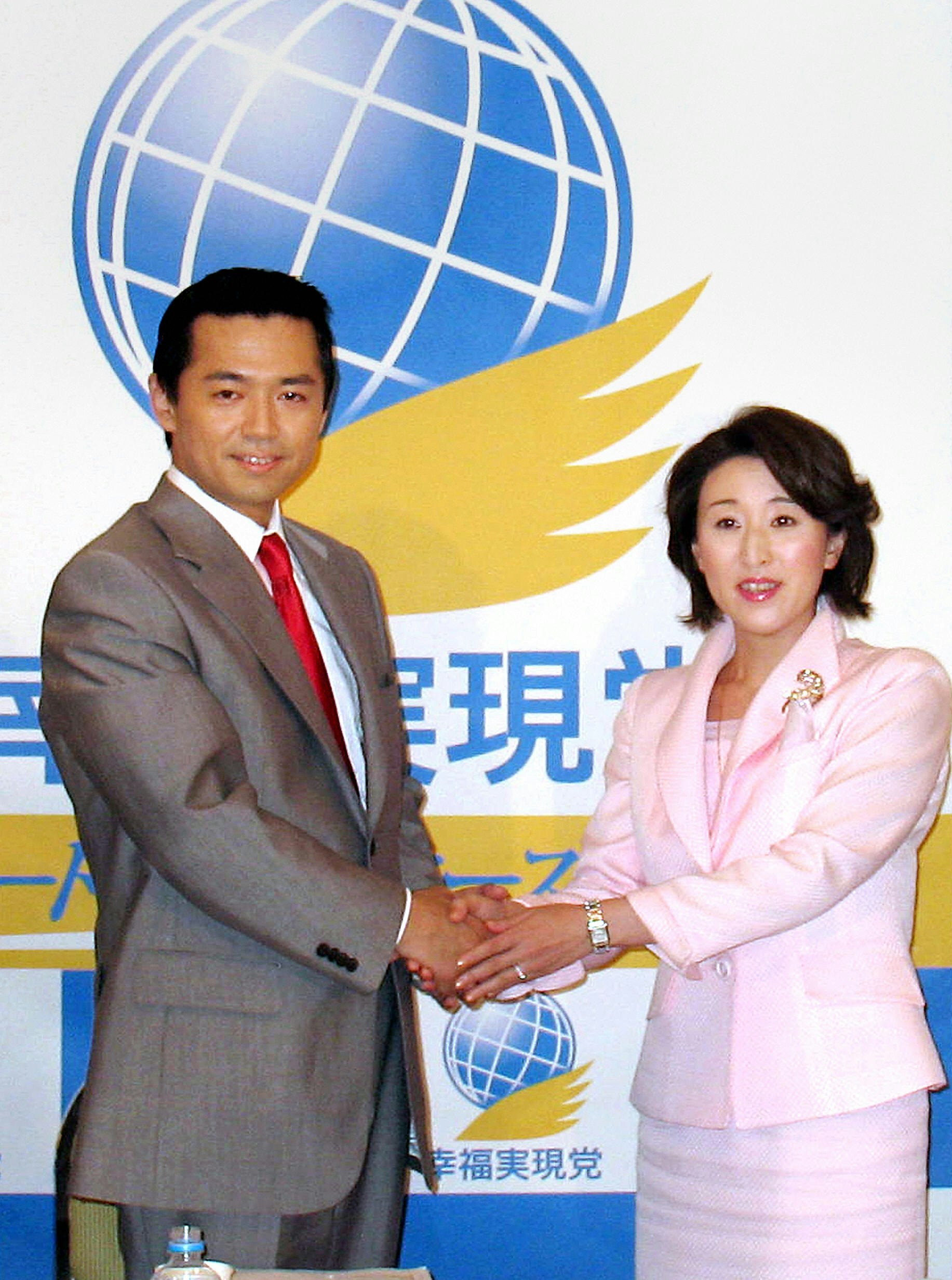
Uncharted hit U.S. theaters in February 2022 to blowout box office success, grossing $150 million in the U.S. as cinemagoers flocked to the Tom Holland-led video game adaptation. The film saw similar gains as it was released across the world… except in Japan, where it only reached third at the box office in its opening weekend.
While Jujutsu Kaisen 0 reigned supreme that weekend, Uncharted’s numbers were just half of another fresh release: The Cherry Bushido, the latest film from the Japanese New Religious group Happy Science.
In The Cherry Bushido, the Republic of Sodorrah — an alleged fictional stand-in for China — fires test missiles over Japan. The government fails to retaliate. After envisaging a future where Tokyo is destroyed, a group of patriotic spiritualists known as the Japan Salvation Conference recruit the film’s protagonist Shizuka to save the country from Sodorrah, which is possessed by the evil spirits Hades and his followers. Shizuka fights arch-enemy Hades using spiritual power and bushido (a samurai moral code) spirit while also railing against Sodorrah to the Japanese people through news conferences. The resulting movie is essentially a bizarre, ultra-nationalist Power Rangers.
Cults and extreme beliefs fascinate us because we are all susceptible to their pull. Cult Week explores these stories — and the liminal spaces between the real and the imaginary.
The film’s producers, Happy Science, are well-versed in this kind of cinema. The organization is what’s known in Japan as a New Religious group, a term that refers to religions and sects that began after the 19th century, although they typically derive from traditional Shinto and Buddhist belief systems.
For its part, Happy Science draws doctrinal inspiration from sources as diverse as Christianity, Buddhism, and New Age spirituality, with Greek mythology and even the myths of the lost continents of Mu and Atlantis mixed in. At the head of Happy Science is its deified leader, El Cantare, a “ninth-dimensional” spirit previously incarnated, according to the group’s canon, as, among others: La Mu, Thos (leaders of the sunken cities of Mu and Atlantis), Buddha, Hermes, and a 66-year old Japanese man named Ryuho Okawa. (Inverse contacted public figures within Happy Science multiple times asking to interview a representative of the group and received no response.)
“The material [of Happy Science] is defined by their use of a variety of different religious concepts such as New Age concepts alongside Japanese and other religious texts, integrating them into one religion and trying to create a coherent worldview where these come together to reveal a hidden pathway guided by their founder, Okawa,” Franz Winter tells Inverse. Winter is a professor of religious studies at the University of Graz in Austria who researches New Religious movements in the East and West.
New Religious groups shape the beliefs of their members but also play a far broader role in Japanese society. For example, Soka Gakkai, a similar group founded in 1930, exert influence beyond their most loyal adherents through their political party, Komeito, which has served as junior partners in a coalition government with the ruling Liberal Democratic Party since 1999. Happy Science, meanwhile, exert their influence through their vast media empire.

The group’s publishing arm, IRH Press, has published over 3,000 books by Okawa, including national non-fiction best-sellers Laws of the Sun and The Golden Laws. Happy Science has its own news outlets in Japanese and English, puts together spiritual self-help magazines. It even operates a child-friendly advice service called Hermes’ Angels. The organization also produces movies through HS Productions, and make use of their own in-house talent agency ARI Productions. The latter is spearheaded by celebrity converts like Yoshiko Sengen, a prominent Japanese actor previously known as Fumika Shimizu with roles in popular franchises such as Kamen Rider and Tokyo Ghoul. Now, Shimizu features exclusively in Happy Science productions.
With such a range and depth of regularly released media content, it’s entirely possible to immerse oneself exclusively in Happy Science’s ideology.
“The very active and aggressive use of media is one thing that sets them apart,” Winter says. “They push their worldview through all areas of the media landscape, and they use advertisements and events on a festival-like scale to spread their claims.”
Beneath a slew of Happy Science-flavored news coverage, mountains of books, and films that range in form from religious sermons to political allegories repackaged as adventure stories is a purpose that goes beyond idle spiritualism. The group’s base also backs the Happiness Realization Party, a political organization similar to Soka Gakkai’s Komeito in its use of religious dogma to effect policy changes, which advocates for a nationalist policy that is inherently anti-China.
Multi-Faceted Media Empire

Happy Science didn’t start life as a religion. It began as the Institute for the Research of Happiness in 1982, which was essentially a study group formed around the founder Okawa’s spiritual “interviews” with various religious and philosophical figures, including Confucius, Moses, and Jesus Christ. Happy Science became a religion in 1986, and in 1991, Okawa declared himself the living incarnation of El Cantare during a sold-out sermon at Tokyo Dome.
The group claims to have over 10 million members worldwide with branches in over 30 countries, but Okawa’s ex-wife and son have both disputed these figures since leaving Happy Science. They allege that membership numbers are as low as 30,000, but more reasonable estimates put it at around 300,000 to 500,000 people. Even so, Happy Science’s popular media empire gives them an outsized cultural influence far beyond a limited core membership: Books, movies, and magazines promote their beliefs in the mainstream and, in their sheer volume and popularity, help legitimize the group’s ideology when criticized by other media players. Two of the biggest publishers in Japan, Kodansha and Shueisha, for example, both saw protests outside their offices or pulled publications critical of the group following complaints from the organization and their followers.
In turn, anyone who knows about Happy Science has most likely heard of them because of their media and what their output reveals about the group’s doctrine and beliefs. Movies like The Laws of the Sun, for example, adapts humanity’s origin story as explained in the Happy Science text of the same name for the big screen. In this tale, humans descend from Venus, and a cat-like Satan corrupts their spirits with materialism and sensuality to make them stray from the Primordial Buddha’s light. In The Golden Laws (another Happy Science foundational text that was later adapted into a movie), the group’s vision of the future and predicted the invention of time travel in the 30th-century fuels an adventure film that visits past El Cantare incarnations.
“If you look at Happy Science’s media output, they diversify.”
The plots of these movies range from the unusual to the extreme and even the offensive. Some of the films feature blatant displays of Sinophobia, historical revisionism, and other extreme beliefs. The 2009 anime film The Rebirth of Buddha appears to demonize people who die by suicide: The film shows their spirits remain trapped on Earth after death, possessing people to commit evil acts and forcing them to a similar fate.
Yet of all the Happy Science movies, its anime films tend to be their most successful. Happy Science’s first feature-length anime was Hermes: Winds of Love (1997). The film recites the group’s dogma telling of one of Okawa’s past lives on Earth while living as Hermes in Ancient Greece. The film begins with a fairly innocuous retelling of the myth of Hermes and Aphrodite before turning into a lecture on the group’s “spiritual pathway.” In general, Happy Science’s tactic seems to be to draw in film audiences with an interesting and neutral initial premise, and then sprinkling in religious sermons about halfway through.
This can be clearly seen in the closest thing the group has to a franchise, the Laws of the Universe. This series of interconnected anime films follows a group of friends through high school and university as they become embroiled in a UFO conspiracy. An alien civilization known as the Gray abducts one of their family members and plants a special chip in her brain. Higher-dimensional Guardian Spirits help the kids fend off the Grays and their masters, the Reptilians.
This wild plot neatly packages Happy Science’s core beliefs about reincarnation and the spirit world within a sci-fi action story. The first of The Laws films even got a major international release from Eleven Arts, who used well-known English voice actors like Yuri Lowenthal. The most recent entry in this series, The Age of Elohim (2021), grossed 840 million yen ($6.2 million), reached No. 1 at the Japanese box office, and beat lifetime grosses for sci-fi films like Dune ($3.7 million) in the country for that year. The Laws franchise riffs directly on Happy Science’s fundamental belief that the world is shaped by El Cantare and that humanity must “fight for faith” against so-called “devilish nations.”
Prolific productions
Happy Science’s production company has released 25 movies in 27 years. Far from being niche, many of these films are released through major Japanese distributor Nikkatsu and use popular genres to target different demographics of Japanese society. The Last White Witch (2019), for instance, is a romance film targeted at teenage and young adult audiences in which the evil spirits that corrupt humanity can be defeated through belief and love. Beautiful Lure (2021) serves a similar message for a more mature audience, while documentaries such as Living in the Age of Miracles (2020) use pseudo-journalism to showcase the healing power of prayer.
These books and movies take Okawa’s ideas that peace and love only come through militarism and authoritarianism to a mass audience. But they also show how the group’s doctrine adapts to the shifting social scene and how it responds to political events.
“The media was crucial to their development and their transformation since the beginning in the late ‘80s and ‘90s, and influenced the image of the leader and doctrine, marketing, economics, and religion,” Erica Baffelli tells Inverse. Baffelli is a researcher at the University of Manchester who focuses on Happy Science.
“If you look at Happy Science’s media output, they diversify. They serve publications that offer a more general New Age-style approach. Then they have publications aiming more at younger women, and they have ones for students,” Baffelli says.
“The ones that are political are extremely explicit, they just tell you that they hate China,” she says.
“They push their worldview through all areas of the media landscape.”
Staying abreast of current affairs is something that the group has done ever since its earliest publications. Their debut feature, The Terrifying Revelations of Nostradamus, was released in 1994 and capitalized on Japanese interest in the philosopher’s apocalyptic predictions. It coincided with numerous commentaries, lectures, and books, often directly linking political events such as the Persian War with the philosopher and Happy Science.
“The media became a way to sustain [their] image,” Baffelli says. “The members I spoke to [in my research] work at companies, they have a family, so they aren’t living on a commune-like some and can read and watch what they want, but they tend to read a lot of insight from in-house publications.”
Just six weeks after the invasion of Ukraine began in the spring of 2022, Okawa published a spiritual interview with Vladamir Putin which he used to criticize President Joe Biden and the threat of sanctions on Russia. The group’s latest feature film, the Uncharted-beating Cherry Bushido, weaves the threat of North Korean nuclear power and Chinese expansion into its narrative. The group’s never-ending media machine means that Happy Science always has an answer for whatever new fear is at the fore of Japanese minds.
Acting out

At the end of Cherry Bushido, it is declared that “Japan will stand up as a divine nation once again.” The protagonist Shizuka embraces the spirit of the fictitious “Ame no Miyoya Gami,” whom, as Happy Science founder Okawa declared in a 2021 speech at Saitama Super Arena, founded Japan when a spaceship landed on a second Mount Fuji in the Japanese peninsula 30,000 years ago. Despite the absurdity of this claim, the falsehood became a book Okawa wrote based on the speech, and Cherry Bushido uses the tale to hearken back to an idealized Japanese spirit.
The film’s plot parallels the group’s tenet that modern-day Japan is in decay, and Happy Science’s doctrine offers a halcyon alternative vision through their books and movies that then feeds up to their political party’s policy points. Happy Science doctrine proclaims a nebulous “corrupting spirit” is the cause of all evil… all while promising its followers enlightenment if only they buy more books and watch more movies.
Happy Science could easily be dismissed as silly. Its ideology suggests, without a hint of irony, that humanity derives from cat-like people who once lived on Venus. The rise of populism around the world shows the degree to which some people feel alienated by mainstream society and the ideas it is founded on. Happy Science and other New Religious groups offer exciting and intoxicating answers to the problems traditional political and religious movements seemingly fail to address.
Ultimately, the group isn’t seeking to replace the status quo. Spirituality shapes modern Japan; most people still visit Shinto and Buddhist shrines on New Year and celebrate religious festivals such as Obon. Some even maintain shrines to deceased loved ones in their homes, despite not necessarily being avid believers in much the same way not everyone who celebrates Christmas is a Christian.
In turn, Okawa's group doesn’t necessarily disregard or supplant the long-held beliefs of Japanese society. Like other New Religious groups, it riffs on more established belief systems and uses education, art, and politics to espouse its worldview. New Religious group Soka Gakkai founded their political wing Komeito in 1964 and Soka University in 1971 as a way to further understanding of their religious aims through education and public policy. Happy Science has done similarly: In the 2000s, the group set up a boarding school for junior high and high school students, where a typical school curriculum was bookended by prayer and activities devoted to the group outside of school hours. Happy Science University followed in 2015. And of course, there is the Happiness Realization Party, founded in 2008.
“The political party was… a way to put themselves back into the agenda, whether good or bad,” Winter says. “It was a way to get their views back onto a platform that could be viewed again by the public.”
These initiatives also reflect a shift in Happy Science’s media to a more overtly political tone. “Spiritual interviews” between Okawa and the Greek philosopher Socrates blasted the supposed naivete of the Japanese government after it refused to accredit Happy Science University due to its curriculum centering on Okawa’s interviews as scientific fact.
In turn, the foundation of the Happiness Realization Party enabled the group to start publishing treatises on fiscal conservatism, historical revisionism, increased military spending, a more aggressive foreign policy towards China and Korea, abolition of the separation of faith and politics, the need for traditional family values, and the view that LGBTQ+ people are both a sign of a decaying society and corrupted by evil spirits.
A changing Japan

Happy Science’s hold on the cultural and political discourse may be about to change, however. Following the assassination of Shinzo Abe on July 8, 2022, New Religious groups throughout Japan are being scrutinized for their links to politics. Abe was apparently targeted by his killer because of his deep connections with the South Korean group the Unification Church (the Moonies). He spoke at their events and even received support from their members in election campaigns. Since July, a further 121 Liberal Democratic Party lawmakers have been revealed to hold substantial ties to the group. Some adopted church positions in exchange for support. The revelations have caused government approval to plummet, and there is intense criticism of the ties between the political establishment and New Religious groups.
How this criticism will affect Happy Science — a group in which religion and politics are nearly indistinguishable from one another — remains to be seen. There is some discussion in Japan regarding new laws that would seek to restrict the activities of groups like them that could seriously affect their endeavors going forward.

What we do know, however, is that Happy Science’s films and the group’s broader media empire are appealing enough to become massive successes in Japan. Together with their political party and education institutes, they show how a charismatic leader whose existence challenges the seemingly ineffectual secular authority can command a broad fan base.
The live-action film Twiceborn, for example, chronicles Okawa’s spiritual awakening based on the book of the same name. Essentially a fictionalized biopic, the film’s protagonist is Satoru Ichijo, and he follows a gilded version of Okawa’s origin story. In the film, Satoru sails through Tokyo University and pulls off record-breaking business deals — but there is no proof the real-life Okawa managed either feat. But Satoru — the fictional Okawa — paints the leader as a person to admire and aspire to emulate.
Perhaps if you craft the narrative skilfully enough, you can at least offer a great story when the real world seems to stop offering a good solution.
Cults and extreme beliefs fascinate us because we are all susceptible to their pull. Cult Week explores these stories — and the liminal spaces between the real and the imaginary. Check out our hub to read more stories about cults and extreme beliefs.







